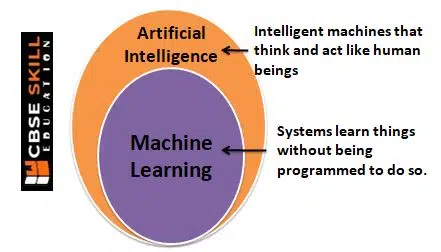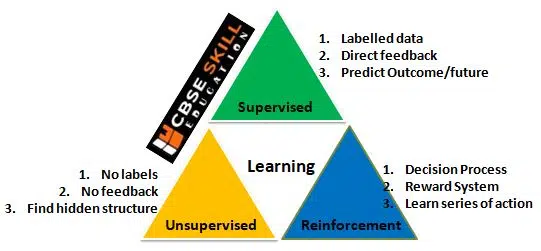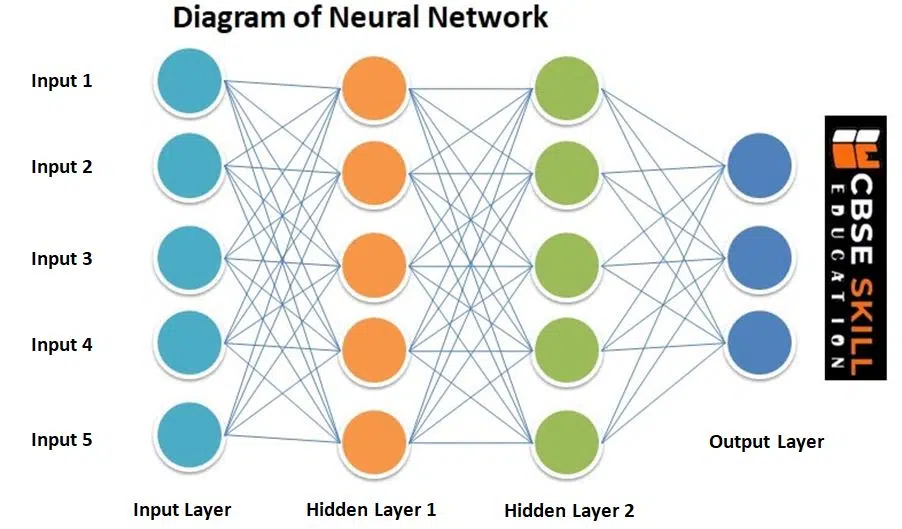Teachers and Examiners (CBSESkillEduction) collaborated to create the Artificial Intelligence Class 11 Notes. All the important Information are taken from the NCERT Textbook Artificial Intelligence (417).
Artificial Intelligence Class 11 Notes
Artificial Intelligence
Artificial intelligence (AI) is a method that enables a machine to carry out all cognitive tasks that would typically be performed by humans, such as perceiving, learning, and reasoning.
“The Science and Engineering of making intelligent machines, especially intelligent Computer programs
is Artificial intelligence” –JOHN MC CARTHY [Father of AI]
World Famous AI Machines
IBM Watson
An IBM supercomputer called Watson uses artificial intelligence (AI) with sophisticated analytical software for the best results as a “question-answering” machine.
Chatbot – Alexa, Sire, Google’s Home
A chatbot is a software program or a computer programme that mimics human conversation through voice or text exchanges. More users are using chatbot virtual assistants to complete simple tasks in business-to-business (B2B) and business-to-consumer (B2C) situations.
Boston Dynamics AI Robot
Boston Dynamics focuses on developing robots with superior dexterity, intelligence, and mobility. Boston Dynamics has introduced the second of its industrial robots. Stretch, a commercially produced warehouse box-moving robot, is now on display after the company introduced Spot, a four-legged robot dog, on the market in 2020.
History of AI
Artificial Intelligence In the year 1950, Since Alan Turning established the “Turning Test” to measure intelligence in the 1950s of the previous century, the field of modern artificial intelligence has gained momentum.
Artificial Intelligence In the year 1955, The term “artificial intelligence” was first used by John McCarthy, considered the father of artificial intelligence. McCarthy has made the most to modern artificial intelligence, along with Alan Turing, Allen Newell, Herbert A. Simon, and Marvin Minsky.
Artificial Intelligence In the year 1970, During the 1970s, the computer era expanded. These devices were more efficient, less expensive, and could store more data. They were incredibly capable of abstract thought, self-recognition, and natural language processing.
Artificial Intelligence In the year 1980, The funding for research and algorithmic tools came over these years. A deeper user experience improved computers and boosted learning abilities.
Artificial Intelligence In the year 2000, Many failed attempts, unfortunately! By the year 2000, the technique had become widely accepted. The milestones were recognised as things that needed to be done. Despite a lack of government funding and popular support, AI might yet succeed.
Artificial Intelligence Based Application
Gmail – automatically separating emails into “Spam” and “Not Spam” categories. Your time is greatly reduced by spam emails being automatically sent to the spam folder.
YouTube – YouTube will suggest videos to view based on their subject and, to a large extent, these suggestions will match the videos you have selected.
Flipkart or Amazon – You’re being advised to purchase products of your choice by Flipkart or Amazon.
Difference between Conventional programming and Machine Learning
While both traditional programming and machine learning (ML) coding are computer programmes, their approaches and goals are different. Like your school uniform and your dress casual, both are made of fabric but serve different purposes.
Conventional Programming – In traditional programming, a human (the programmer) creates the programme by hand. However, since the logic is not programmed, rules must be manually created or manually coded.

Take a look at an example. Below are the steps to convert Celcius scale to Fahrenheit scale
Step -1: Take input (Celcius)
Step-2: Apply the conversion formula: Fahrenheit = Celcius * 1.8 + 32
Step -3: Print the Output (Fahrenheit)
Machine Learning – machine learning, the algorithm automatically creates the rules from the data. Data preparation, natural language user interfaces, automatic outlier detection, recommendations, causality and importance recognition, and many more areas can all see a rise in the value of your embedded analytics. All of these characteristics contribute to accelerating user insights and lowering bias in decisions.

For example, if the same Python program above is to be written using the Machine Learning approach, the code will look like this:
Step 1: Feed lot many values in Celcius (i.e. -40, -10, 0, 8, 15, 22, 38)
Step -2: Feed corresponding Fahrenheit values (i.e. -40, 14, 32, 46, 59, 72, 100)
Step -3: Pass these 2 sets of values to Machine Learning (ML) algorithm
Step- 4: Now you ask the ML program to predict (convert) any other celcius value to Fahrenheit, and program will tell you the answer.
AI is a field of study that aims to develop intelligent computers with human-like abilities, such as speech recognition, vision, information assimilation, planning, and problem-solving. In general, AI encompasses all disciplines or technologies that seek to build intelligent machines.
Without being formally programmed, machine learning enables machines to learn, forecast, and advance on their own. To put it simply, machine learning is all about learning. A typical ML system begins in a “slow state” (similar to that of a toddler) and eventually becomes “superior” by learning from examples (like an adult).

What is Data? Define it.
Data is a representation of information that can be processed or transmitted by humans or machines. Examples include information about students, schools, sports teams, businesses, and animals. A collection of information, such as statistics, words, images, photos, audio or video clips, maps, measurements, observations, or even just a simple description of something, is called data.
Type of Data
- Structured Data
- Unstructured Data
Structured Data
The most common kind of “structured data” is “quantitative data,” and most of us deal with this kind of data on a daily basis. Structured data contains established data types and formats that make it easy to insert into database columns and spreadsheet fields. They are well-organized and simple to analyse.
Examples of structured data is name, age, address etc.
Unstructured Data
The most common definition of “unstructured data” is qualitative data, which cannot be handled or analysed using traditional relational database (RDBMS) techniques.
Examples of unstructured data include text, video, audio, mobile activity, social media activity, satellite imagery, surveillance imagery and the list goes on.
Terminology and Related Concepts
Machine Learning
“Machine learning is the science of getting computers to act without being explicitly programmed.” – Stanford University
“Machine learning algorithms can figure out how to perform important tasks by generalizing from examples.” – University of Washington
The term “machine learning” (ML) is now used to refer to an application of AI that gives the system the capacity to learn from experience and advance utilising the data at its disposal.
Supervised, Unsupervised and Reinforcement learning
Machine learning is often divided into three categories – Supervised, Unsupervised and Reinforcement learning.

Supervised Learning
An strategy to developing artificial intelligence (AI) known as supervised learning involves training a computer system on input data that has been labelled for a certain output.
Unsupervised Machine Learning
An method known as unsupervised learning discovers patterns in untagged data. The idea is to drive the machine to create a concise internal model of its environment through imitation, which is a key learning strategy for humans, and then draw creative inspiration from it.
Reinforcement Machine Learning
A machine learning training method called reinforcement learning rewards desired behaviours and/or penalises undesirable ones. A reinforcement learning agent can typically perceive and comprehend its surroundings, act, and learn by making mistakes.
Deep Learning and Neural Networks
A neural network is an artificial intelligence technique that instructs computers to analyse data in a manner modelled after the human brain. It is a kind of artificial intelligence technique known as deep learning that makes use of interconnected neurons or nodes in a layered structure to mimic the human brain.
Artificial neural networks used in deep learning are modelled after brain-like neural networks. The theory behind ANN in deep learning is that the human brain forms the correct connections to carry out its functions, and that this pattern can be replicated using silicon and wires in place of living neurons.
Artificial Neural Network
Artificial neural networks (ANNs) are layers of computer programme components called neurons (also known as nodes), coupled to other neurons in a layered fashion. Until they can categorise the data as an output, these networks transform the data from one neuron to another. Another method to create a computer programme that learns from data is the neural network.

The three distinct nodes known as input, hidden, and output make up the neural network structure that is used the most frequently.
Input Node – The input node is the layer of the neural network where information or initial data from the outside world is entered. After that, the data is sent to the concealed node, where calculations can start.
Hidden Node – At this point, there is no link to the outside world. The machine uses the data it obtained from the input node at this stage to perform computation and processing on it. More than one concealed layer is possible.
Output Node – The final step is the output node, when computations are completed and data is made available to the output layer for subsequent transport back into the physical world.
Deep Learning
Deep learning is a subset of machine learning that is entirely based on artificial neural networks. Since neural networks resemble the functioning of the human brain, deep learning is also a form of brain impersonation. We don’t have to explicitly programme everything in deep learning. It’s crucial to understand that not everything in deep learning needs to be explicitly programmed.
Let us now understand the difference between Machine Learning and Deep Learning:
| MACHINE LEARNING | DEEP LEARNING |
|---|---|
| Works on small amount of Dataset for accuracy. | Works on Large amount of Dataset. |
| Dependent on Low-end Machine. | Heavily dependent on High-end Machine. |
| Divides the tasks into sub-tasks, solves them individually and finally combine the results. | Solves problem end to end. |
| Takes less time to train | Takes longer time to train. |
| Testing time may increase. | Less time to test the data. |
Here are a few examples of Deep Learning at Work:
Automated Driving – To detect objects like stop signs and traffic lights robotically, automotive experts are employing deep learning. Deep learning is also utilised to recognise pedestrians, which lowers the likelihood of accidents.
Aerospace and defence – Another application of deep learning is in the identification of satellite-observed objects and the location of safe and risky areas for troops.
Medical Research – Cancer researchers utilise deep learning to automatically identify cancer cells.
Industrial Automation – By automatically determining when individuals or things are too close to heavy machinery, deep learning is assisting in enhancing worker safety around such equipment.
What machine learning can and cannot do?
Here are a few examples of Machine Learning that we use every day:
Virtual Personal Assistant – like Siri, Alexa, Google Home etc.
Predictions while commuting – like Traffic Forecasts on Google Maps.
Video Surveillance – Modern video surveillance systems use artificial intelligence (AI) to detect crimes before they occur. They observe people’s strange behaviour, such as prolonged periods of inactivity, stumbling, or snoozing on benches, etc.
Social Media Services – Facebook suggests friends to you based on your connections with them and how frequently you visit their accounts. A list of Facebook members who you can add as friends is provided based on ongoing learning.
Filtering of email spam and viruses – Emails are organised in accordance with some guidelines for email spam. Receiving emails is managed by mail filtering, which also finds and deletes emails containing dangerous codes like viruses, Trojans, or malware.
Product recommendations – After you shop online for a product, you frequently receive emails from related merchants. The products are either comparable or suit your preferences, which undoubtedly improves the buying experience.
Online Fraud Detection – Machine learning is lending its potential to make cyberspace a secure place by tracking monetary frauds online.
Jobs in AI
- Data Analytics
- Research Scientist
- Researcher
- Software Engineer
- AI Engineer
- Data Mining and Analysis
- Machine Learning Engineer
- Data Scientist
- Business Intelligence (BI) Developer
- Big Data Engineer/Architect
Employability Skills Class 11 Notes
- Unit 1 : Communication Skills – III
- Unit 2 : Self-Management Skills – III
- Unit 3 : Information and Communication Technology Skills – III
- Unit 4 : Entrepreneurial Skills – III
- Unit 5 : Green Skills – III
Employability Skills Class 11 MCQ
- Unit 1 : Communication Skills – III
- Unit 2 : Self-Management Skills – III
- Unit 3 : Information and Communication Technology Skills – III
- Unit 4 : Entrepreneurial Skills – III
- Unit 5 : Green Skills – III
Employability Skills Class 11 Questions and Answers
- Unit 1 : Communication Skills – III
- Unit 2 : Self-Management Skills – III
- Unit 3 : Information and Communication Technology Skills – III
- Unit 4 : Entrepreneurial Skills – III
- Unit 5 : Green Skills – III
Subject Specific Skills Notes
- Unit 1: Introduction To AI
- Unit 2: AI Applications & Methodologie
- Unit 3: Maths For AI
- Unit 4: AI Values (Ethical Decision Making)
- Unit 5: Introduction To Storytelling
- Unit 6: Critical & Creative Thinking
- Unit 7: Data Analysis (Computational Thinking)
- Unit 8: Regression
- Unit 9: Classification & Clustering
- Unit 10: AI Values (Bias Awareness)
